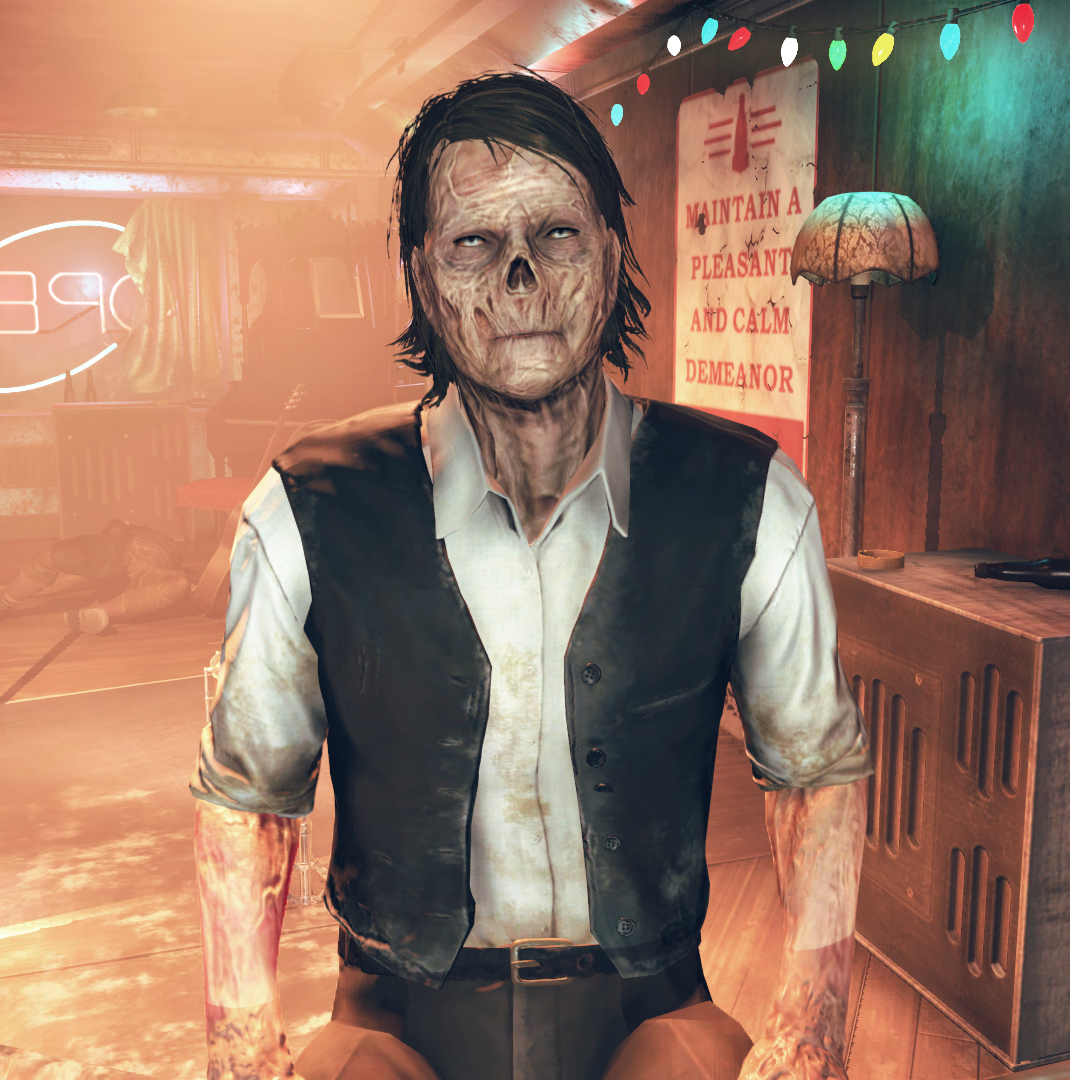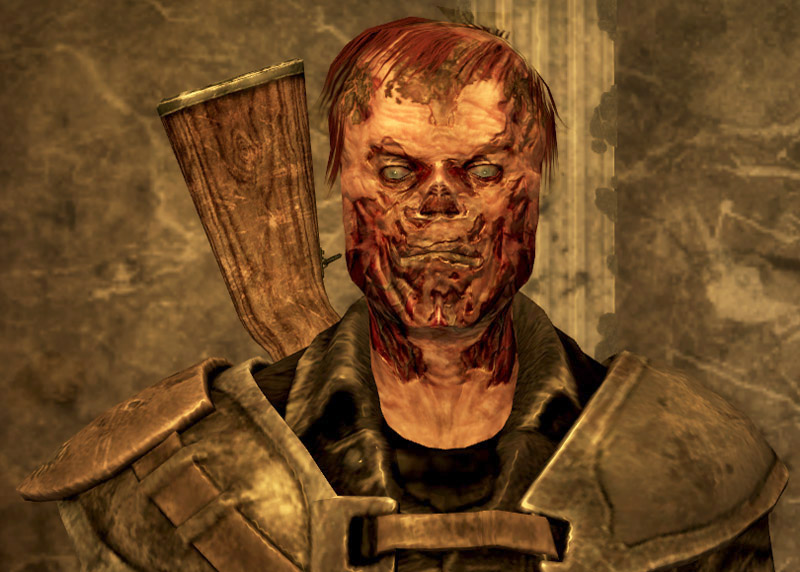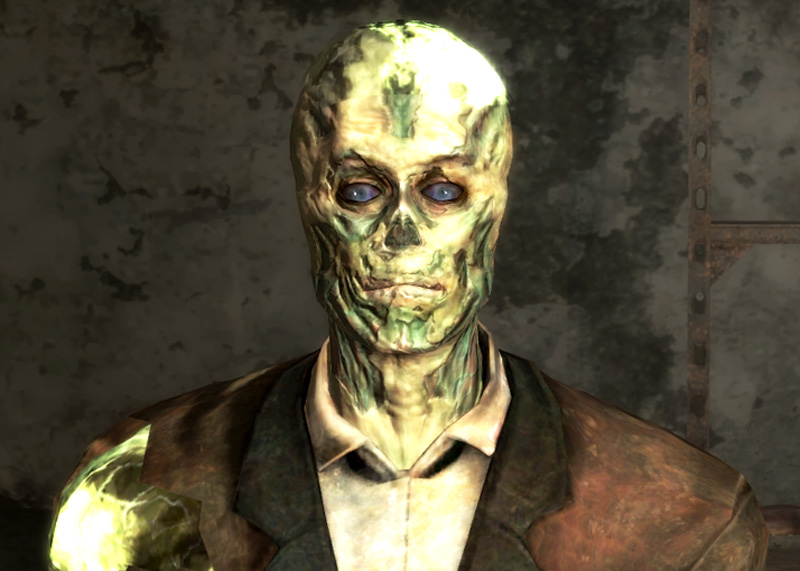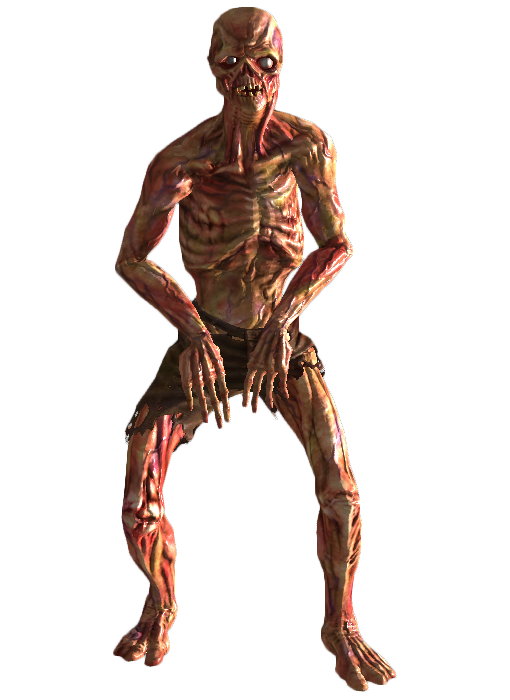Ghoul, Fallout Variant (5e Race)
Ghoul, Fallout Variant[edit]
| “ | I don't have to tell you that Bright's group has got some fine-looking ghoulettes in it! Eh...or maybe I would have to tell you... | ” |
| —Harland, Fallout: New Vegas | ||
Physical Description[edit]

|
|---|
Ghouls are mutated humans or animals affected by the phenomenon of ghoulification. In the case of humans, ghouls are sometimes referred to as necrotic post-humans in the Capital Wasteland, but this term does not seem to have been adopted outside of it whatsoever. Despite their zombie-like appearance, the flesh of ghouls is not actually rotten. Intense and prolonged radiation has ravaged their skin, much of their flesh, and in some cases many of their ligaments. Despite their infertility and in some cases mental deterioration, they have greatly extended overall lifespans and are immune to (and sometimes even healed by) background radiation and/or nuclear fallout.
Origin[edit]
High levels of radiation are a crucial factor, but radiation poisoning typically results in death, rather than ghoulification. There are two primary ways in which ghouls can develop from a human. Irradiation and gradual transformation result in ghouls who retain their general human shape, but with a high degree of skin deterioration: Exposed muscle, flaking skin, and damaged connective tissue characterized by the absence of nose and ears. Another is surviving a nuclear blast relatively close to ground zero, suffering burns both thermal and radiation-induced, but surviving. The latter transformation is typically faster and substantially more traumatic for the victim and results in a generally much more horrifying appearance, with exposed bone, asymmetric deformations, and extensive unhealed wounds.
The vast majority of ghouls of both types have developed as a result of exposure during the Great War, but ghoulification is also possible after the War. Camp Searchlight is one such example, with an attack that transformed a majority of the NCR troopers stationed there into ghouls. Camp Searchlight also emphasizes the fact that the nature of the transformation may lead to mental problems. The trauma of transformation can cause a mental breakdown in the victim, causing a rapid degeneration of higher thought processes, causing them to become feral. Moreover, particularly severe irradiation can lead to the creation of luminous necrotic post-humans, or glowing ones with a permanently damaged brain: feral glowing ones are almost invariably hostile.
History[edit]
The history of ghouls is a mixture of suffering and plight. The bulk of ghouls emerged as a result of the Great War, although there are cases of some using controlled exposure to radiation to ghoulify themselves and ride out the upcoming war. There was also an experimental radiation drug being tested somewhere in the Commonwealth. Its known side effects are why Hancock sought out the last remaining dosage.
Society[edit]
In California, ghouls were the first group of survivors to begin rebuilding civilization – the inhabitants of Vault 12 beneath Bakersfield founded the Necropolis in the summer of 2083. Less than a year later, in 2084 Set wrestled control of the settlement from the original overseer and instituted his own reign, characterized by delusions of grandeur. The city would eventually decline, starting with the attack by Unity in 2157, who expected to find an unopened Vault in the ruins of the city. After many ghouls were killed in the assault, Set negotiated peace with the super mutants, after explaining that the ghouls are indeed the vault dwellers. The recovery operation failed, but Unity established a stronghold in the town to ensure Set's cooperation and watch for humans. It would finally be destroyed and most of its population killed in a retaliatory expedition by the super mutants, sent to the city after the Vault Dweller raided the Vault and recovered the water chip, eliminating the super mutant garrison in the process. This has led to a great migration and the eventual founding of a number of ghoul and ghoul-friendly settlements, including Broken Hills in 2185, the NCR state of Dayglow around 2189, and Gecko in 2235. Though problems with equality continue, ghouls are increasingly seen as equal members of society, though their numbers steadily dwindle. Sometime in 2242 marked the end for both Broken Hills and Gecko as they relied on the selling of and using of uranium that was mined.
In the Mojave Wasteland, they can be found in small amounts throughout the region, but no town is completely dedicated to them. There are usually a few ghouls living among humans in various communities performing jobs in order to survive, such as the guard Beatrix Russell and the comedian Hadrian, both of which are in Freeside. The only known community of ghouls in the region is the Bright Brotherhood, a religious faction located in the REPCONN test site, founded and led by an intelligent glowing one named Jason Bright, who wants to leave Earth and go into space to find a "new world," a promised land foretold by Bright himself. There are also several ghoul rangers occupying Ranger Station Echo, implying some level of acceptance of ghouls serving in the NCR. In contrast, Caesar's Legion does not allow ghouls (along with other mutants) within their ranks, but do allow ghouls to live in their territory, such as Raul Tejada who traveled from Two Sun to the Mojave. To Caesar, ghouls and other mutants are irrelevant to his plans to push westward.
In 2277, in the Divide, nuclear warheads triggered by the Courier's delivery of an automated nuclear launch device exploded and triggered rapid ghoulification of the Legion and NCR forces engaged in battle there. The Divide flayed them alive, causing them to become dead men walking – marked for death, sustained only by the intense radiation that permeates the area. As they never appear outside the Divide, due to the necessity of staying near radiation sources to remain alive, the marked men became a legend in the wasteland, like the Sierra Madre, the Burned Man, or the Big Empty.
The densely urbanized East had a great concentration of American population and was strongly affected by the nuclear fallout. People who took shelter in areas affected by it experienced radiation poisoning; those who did not die became ghouls. Within a year, the first ghouls began to appear and with them, the first fledgling settlements, like Underworld in Washington, D.C., which existed as late as 2277. Although in areas like Appalachia, ghouls were quickly sought out and exterminated, no matter what relation they may have had with others before they became Ghouls. Another population of ghouls, transformed Chinese operatives stranded on American soil, chose to sequester themselves from the wasteland.
In other areas, like the Commonwealth, ghouls cohabited with humans. The most noticeable example was Diamond City. Ghouls were a part of the city's population from its foundation in the 2130s to the 2282 election. Diamond City was gripped by a wave of racism, thanks to a candidate by the name of McDonough. He ran for the city's mayor on the Mankind for McDonough platform and won the election thanks to the votes of the Upper Stands citizens. After his election, ghoul citizens were evicted. Entire families were thrown out of the city by their human neighbors, straight into the surrounding ruins to perish without a cap to their name. Those that survived scattered across the region. A refugee called Wiseman founded the Slog, the foremost tarberry farm in the Commonwealth.
After the war, a pre-War mall known as Valley Galleria became a haven for ghouls in Appalachia, referred to by survivors as "the Changed." Led by Lucy Harwick, the ghouls sheltering in the Galleria welcomed others like them to travel there and be accepted with "open arms, and more importantly, open hearts." However, because of bigotry associated with feral ghouls, Duncan McKann would murder Lucy Harwick and several others in a single-minded pursuit for revenge.
By 2103, after the mass migrations and settlement of the Crater and Foundation, sentient ghouls would make a return with humans. Ghouls would work among groups of humans, such as Eugenie of the Blue Ridge Caravan Company, and Mordecai McCoy would find steady work entering radioactive areas to scavenge goods and a general handyman around The Wayward. Despite the common and vital roles that ghouls would fill, ghouls would still suffer persecution for their appearance and incorrect association with feral ghouls. The Settlers of Foundation would hold the policy of shooting ghouls on sight at the gates because of feral ghoul problems. Once Penelope Hornwright is recruited for the Settlers portion of Wastelanders, she comments on having to wear a full mask disguise in order to enter Foundation. The Raiders of the Crater are slightly more tolerant of ghouls among their ranks, but some share an innate bigotry for ghouls, such as Lev who would attempt to make Lou commit suicide by guilting him that he would become feral someday.
Ghoul, Fallout Variant Names[edit]
Most ghouls remember their name before ghoulification so they have a normal human names, unless they are feral, in which case they may have names that they adopted.
Male Feral: Meat, Atom's Champion, Patchwork
Female Feral: Red, Tulip, Snowflake
Ghoul, Fallout Variant Traits[edit]
| Ghouls are mutated humans or animals affected by the phenomenon of ghoulification. Ability Score Increase. Your Constitution score increases by 2. Age. Ghouls have a longer lifespan thanks to their altered DNA from the radiation. They live upwards of 500 years. Alignment. If they are sentient they usually follow whatever alignment they were when they were human. Size. Ghouls vary widely in height and build, from barely 5 feet to well over 6 feet tall. Your size is Medium. Speed. Your base walking speed is 30 feet. |
| "Darkvision". In addition to being able to see in normal light, you can see in dim light within 60 feet of you as if it were bright light, and in darkness as if it were dim light. You can discern color in darkness. |
| Undead.. Your creature type is undead. |
| Inexhaustible.. You don't need much of a break, having no flesh. You have advantage on Constitution saving throws against exhaustion. |
| Languages. You can speak, read, and write Common and one other language of your choice. |
Subraces[edit]
Necrotic post-human (ghoul)[edit]

|
|---|
Commonly referred to as ghouls, these men and women are no different from regular humans when it comes to intellect or personality. Ghouls possess the ability to talk, and they normally wear clothing, as well as carrying and using weapons. Ghouls often refer to humans as "smoothskins."
These ghouls also find terms such as "shuffler" and "zombie" to be offensive. The phrase is also used to threaten ghouls. Those bigoted towards ghouls use the two phrases interchangeably, stating that ghouls should be killed before the "go zombie" due to radiation destroying their brains. Some ghouls have embraced the phrase, such as those in Set's Zombies gang. Similarly, Raul Tejada uses the word zombie when referring to a nickname of his, "Raul the Ghoul, the zombie vaquero of Mexico City."
Hostile intelligent ghouls, violent even without provocation, do exist, the most noteworthy being the Chinese remnants, Chinese spies, soldiers, and special forces units trapped in the United States following the Great War. Remnant forces are wholly unaware (or perhaps in denial) of the worldwide nuclear destruction that has occurred and believe that they are still in a state of war, continuing to follow old objectives sent to them pre-War by the People's Liberation Army.
Ability Score Increase. Your Intelligence score increases by 1.
Calculated. You can choose to reroll a failed attack roll, ability check, or saving throw. Once you have done so once, you cannot do so again until you finish a long rest.
Death Sight. When looking at a creature, you can instantly tell whether it is dead, undead, or alive. This does not work on constructs.
Luminous necrotic post-human (glowing one)[edit]

|
|---|
A highly irradiated ghoul that has absorbed enough radiation to develop bioluminescence, glowing a ghastly green color that's especially visible in the dark. They are colloquially known by most as "glowing ones," and are often considered outsiders even by other ghouls. Glowing Ones are predominantly feral, due to isolation and the time it takes to acquire that much radiation. Although uncommonly they may transition into this state before losing their faculties. See this section for more details.
From Fallout 3 onwards, Glowing Ones are particularly difficult in combat due to their resilience and the ability to suddenly discharge radiation from their body in a room sized "blast" that harms non-ghoul targets and heals ghouls.
People have seen on more than one occasion a feral glowing one fighting or being chased by "normal" feral ghouls. Although very rare, it is possible for a glowing one to retain their intelligence and cognitive functions, such as Jason Bright, Oswald the Outrageous, and several unnamed ghouls in Necropolis and most of the technicians at the Gecko power plant.
Ability Score Increase. Your Strength score increases by 1.
Death's Embrace. You bring the wrath of death when you strike your foes. When you make a successful weapon attack against a creature, you can choose to deal an extra 2d4 necrotic damage. The damage increases by 1d4 at levels 5 (3d4), 9 (4d4), 13 (5d4), and 17 (6d4). You must complete a short or long rest before using this trait again.
Dark Sigil. You are no mere skeleton and other undead can tell. Undead can tell you are one of them and if you are stronger than them, unless attacked or ordered to, undead won’t attack you.
Ferocious necrotic post-human (feral ghoul)[edit]

|
|---|
These are ghouls who have irreversibly transitioned to a feral state, sustained only by radiation they absorb. Ferals are invariably hostile to living creatures (with the exception of other ghouls, including non-ferals) and tend to cluster together in packs. Feral ghouls are among the more unfortunate mutants whose minds have deteriorated from prolonged radiation poisoning, becoming instinct-driven savages, attacking anyone and anything relentlessly, save for other ghouls. They are roughly divided into groups according to the danger they pose:
Regular feral ghouls wear torn, shredded civilian clothes and are very easy to dispatch. Feral ghoul roamers and stalkers are often wearing rags or no clothes at all. They are considerably tougher than a normal feral ghoul and considerably more dangerous with their attacks. Feral ghoul reavers are the most deteriorated form of a feral ghoul, wearing bits of metal armor and metal flight suits. Radiation has melted and fused entire segments of their body, making them incredibly tough to dispatch. In Fallout 3, even worse is the fact that reavers have no self-preservation instinct and will readily rip out its radioactive guts and throw them at their targets. Withered, gangrenous, rotting, and charred feral ghouls are the rarest of feral ghoul subtypes and the most dangerous given their resilience to being dispatched and considerably deadly attacks.
Ability Score Increase. Your Dexterity score increases by 1.
Amnesia. You remember nothing of your past self
Zombie Healing. In lieu of taking any other actions in a round you can elect to spend one Hit Die to heal yourself. You can do this as many times in a day as you have Hit Dice left. Once you've run out of Hit Dice you must take a long rest to regain the Hit Dice, as normal.
Random Height and Weight[edit]
| Base Height |
Height Modifier* |
Base Weight |
Weight Modifier** |
|---|---|---|---|
| 5′ 2'' | +2d6 | 100 lb. | × (1d100) lb. |
|
*Height = base height + height modifier | |||
Back to Main Page → 5e Homebrew → Races
